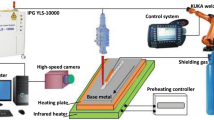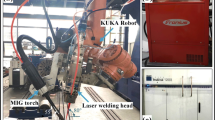Abstract
Laser–metal inert gas (MIG) welding is a promising welding technology, which presents many attractive properties. However, porosity still remains a serious problem in laser–MIG welding of aluminum. In this experimental study, the effect of leading configuration on porosity formation and distribution in laser–MIG bead-on-plate welding of A7N01 alloy was investigated. Experiments on arc current, welding speed, and arc configuration were performed comparatively for two leading configurations, respectively. The welds were analyzed with X-ray photographs and cross-section observations. Pores in laser–MIG-welded samples were mainly keyhole-induced. The concept of porosity area fraction was used to evaluate the severity of pore defect. The maximum porosity area fraction presented at different arc currents in the two leading configurations (in laser leading welding, it is 150 A, while in arc leading welding, it is 110 A). With welding speed increasing, porosity area fraction decreased. Bubble escape condition was deduced and used to discuss the probable mechanism of the effect of leading configuration on pore formation. The results showed that leading configuration was considerable in porosity minimization and prevention.
Similar content being viewed by others
References
Steen WM, Eboo M (1979) Arc augmented laser-welding. Met Constr-Brit Weld 11(7):332–336
Le Guen E, Fabbro R, Carin M, Coste F, Le Masson P (2011) Analysis of hybrid Nd:Yag laser-MAG arc welding processes. Optics & Laser Technology 43(7):1155–1166. doi:10.1016/j.optlastec.2011.03.002
Wang J, Wang GZ, Wang CM (2015) Mechanisms of the porosity formation during the fiber laser lap welding of aluminium alloy. Metalurgija 54(4):683–686
Casalino G, Mortello M, Leo P, Benyounis KY, Olabi AG (2014) Study on arc and laser powers in the hybrid welding of AA5754 Al-alloy. Mater Design 61:191–198. doi:10.1016/j.matdes.2014.04.060
Ola OT, Doern FE (2015) Keyhole-induced porosity in laser-arc hybrid welded aluminum. Int J Adv Manuf Tech 80(1–4):3–10. doi:10.1007/s00170-015-6987-4
Campana G, Ascari A, Fortunato A, Tani G (2009) Hybrid laser-MIG welding of aluminum alloys: the influence of shielding gases. Appl Surf Sci 255(10):5588–5590. doi:10.1016/j.apsusc.2008.07.169
Katayama S, Uchiumi S, Mizutani M, Wang J, Fujii K (2007) Penetration and porosity prevention mechanism in YAG laser-MIG hybrid welding. Weld Int 21(1):25–31. doi:10.1533/wint.2007.3680
Wang QY, Chen H, Zhu ZT, Qiu PX, Cui YL (2016) A characterization of microstructure and mechanical properties of A6N01S-T5 aluminum alloy hybrid fiber laser-MIG welded joint. Int J Adv Manuf Tech 86(5–8):1375–1384
Liu S, Li JM, Mi GY, Wang CM, Hu XY (2016) Study on laser-MIG hybrid welding characteristics of A7N01-T6 aluminum alloy. Int J Adv Manuf Tech 87(1–4):1135–1144
Katayama S, Uchiumi S, Briand F (2006) Production of sound deep-penetration hybrid weld in aluminum alloy with YAG laser and MIG arc. Proceedings of the 22nd ICALEO, 953–959
Leo P, Renna G, Casalino G, Olabi AG (2015) Effect of power distribution on the weld quality during hybrid laser welding of an Al-Mg alloy. Opt Laser Technol 73:118–126
Kah P, Salminen A, Martikainen J (2010) The effect of the relative location of laser beam with arc in different hybrid welding processes. Mechanika 3:68–74
Zhao L, Sugino T, Arakane G, Tsukamoto S (2009) Influence of welding parameters on distribution of wire feeding elements in CO2 laser GMA hybrid welding. Sci Technol Weld Joi 14(5):457–467. doi:10.1179/136217109x434252
Casalino G, Campanelli SL, Dal Maso U, Ludovico AD (2013) Arc leading versus laser leading in the hybrid welding of aluminium alloy using a fiber laser. Procedia CIRP 12:151–156. doi:10.1016/j.procir.2013.09.027
Katayama S, Mizutani M (2003) Elucidation of laser welding phenomena and porosity formation mechanism (physics, processes, instruments & measurements, international symposium of JWRI 30th anniversary). Trans JWRI 32:67–69
Haboudou A, Peyre P, Vannes AB (2004) Influence of surface preparation and process parameters on the porosity generation in aluminum alloys. J Laser Appl 16(1):20–24. doi:10.2351/1.1619995
AlShaer AW, Li L, Mistry A (2014) The effects of short pulse laser surface cleaning on porosity formation and reduction in laser welding of aluminium alloy for automotive component manufacture. Opt Laser Technol 64:162–171. doi:10.1016/j.optlastec.2014.05.010
Yao W, Gong SL (2011) Porosity formation mechanisms and controlling technique for laser penetration welding. Adv Mater Res-Switz 287-290:2191–2194. doi:10.4028/www.scientific.net/AMR.287-290.2191
Zhao H, White DR, DebRoy T (1999) Current issues and problems in laser welding of automotive aluminium alloys. Int Mater Rev 44(6):238–266. doi:10.1179/095066099101528298
Pang SY, Chen X, Zhou JX, Shao XY, Wang CM (2015) 3D transient multiphase model for keyhole, vapor plume, and weld pool dynamics in laser welding including the ambient pressure effect. Opt Laser Eng 74:47–58. doi:10.1016/j.optlaseng.2015.05.003
You DY, Gao XD, Katayama S (2015) Detection of imperfection formation in disk laser welding using multiple on-line measurements. J Mater Process Tech 219:209–220. doi:10.1016/j.jmatprotec.2014.12.025
Wei PS, Wu JH, Chao TC, Chen LJ (2014) Keyhole collapse during high intensity beam drilling. Int J Heat Mass Tran 79:300–308. doi:10.1016/j.ijheatmasstransfer.2014.07.070
Gatzen M, Thomy C, Vollertsen F (2012) Analytical investigation of the influence of the spatial laser beam intensity distribution on keyhole dynamics in laser beam welding. Laser Eng 23(1–2):109–122
Zhou J, Tsai HL (2007) Effects of electromagnetic force on melt flow and porosity prevention in pulsed laser keyhole welding. Int J Heat Mass Tran 50(11–12):2217–2235. doi:10.1016/j.ijheatmasstransfer.2006.10.040
Haboudou A, Peyre P, Vannes AB, Peix G (2003) Reduction of porosity content generated during Nd:YAG laser welding of A356 and AA5083 aluminium alloys. Mat Sci Eng a-Struct 363(1–2):40–52. doi:10.1016/S0921-5093(03)00637-3
El-Batahgy A, Kutsuna M (2009) Laser beam welding of AA5052, AA5083, and AA6061 aluminum alloys. Adv Mater Sci Eng . doi:10.1155/2009/974182Artn 974182
Lisiecki A, Burdzik R, Siwiec G, Konieczny L, Warczek J, Folega P, Oleksiak B (2015) Disk laser welding of car body zinc coated steel sheets. Arch Metall Mater 60(4):2913–2922. doi:10.1515/amm-2015-0465
Ahsan MRU, Kim YR, Kim CH, Kim JW, Ashiri R, Park YD (2016) Porosity formation mechanisms in cold metal transfer (CMT) gas metal arc welding (GMAW) of zinc coated steels. Sci Technol Weld Joi 21(3):209–215. doi:10.1179/1362171815y.0000000084
Chang B, Allen C, Blackburn J, Hilton P (2013) Thermal and fluid flow characteristics and their relationships with porosity in laser welding of AA5083. Physcs Proc 41:471–480. doi:10.1016/j.phpro.2013.03.104
Mohandas T, Banerjee D, Rao VVK (1999) Fusion zone microstructure and porosity in electron beam welds of an alpha plus beta titanium alloy. Metall Mater Trans A 30(3):789–798. doi:10.1007/s11661-999-0071-3
Gao M, Zeng XY, Hu QW, Yan J (2008) Weld microstructure and shape of laser-arc hybrid welding. Sci Technol Weld Joi 13(2):106–113. doi:10.1179/174329307x249388
Zhang KZ, Lei ZL, Chen YB, Liu M, Liu Y (2015) Microstructure characteristics and mechanical properties of laser-TIG hybrid welded dissimilar joints of Ti-22Al-27Nb and TA15. Opt Laser Technol 73:139–145. doi:10.1016/j.optlastec.2015.04.028
Author information
Authors and Affiliations
Corresponding author
Rights and permissions
About this article
Cite this article
Miao, H., Yu, G., He, X. et al. Comparative study of hybrid laser–MIG leading configuration on porosity in aluminum alloy bead-on-plate welding. Int J Adv Manuf Technol 91, 2681–2688 (2017). https://doi.org/10.1007/s00170-016-9917-1
Received:
Accepted:
Published:
Issue Date:
DOI: https://doi.org/10.1007/s00170-016-9917-1




